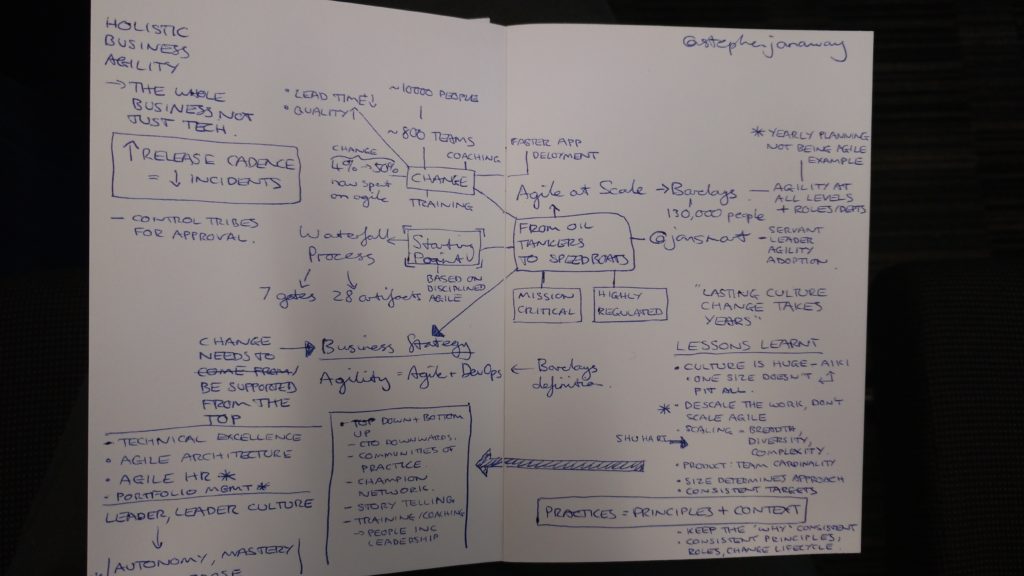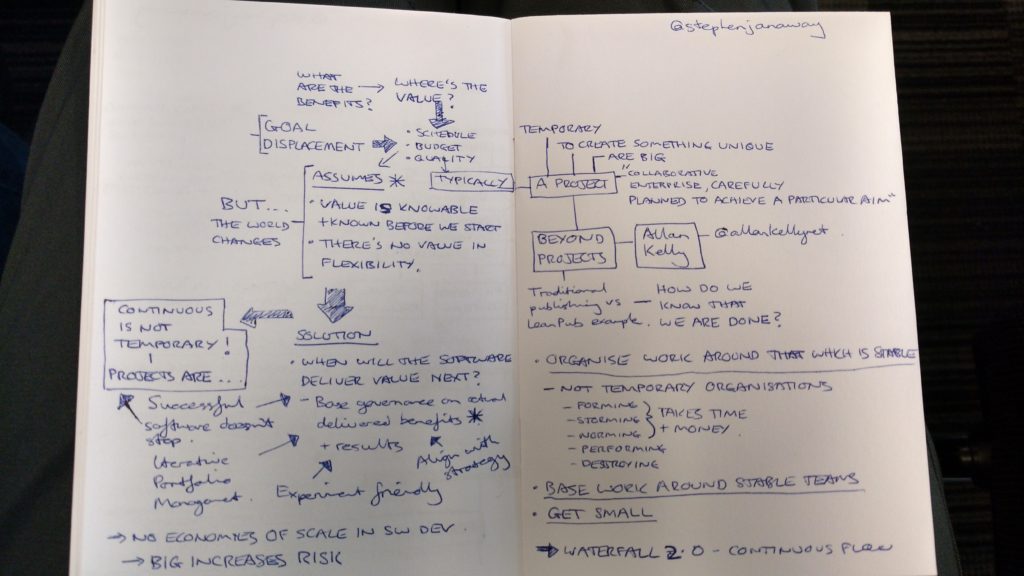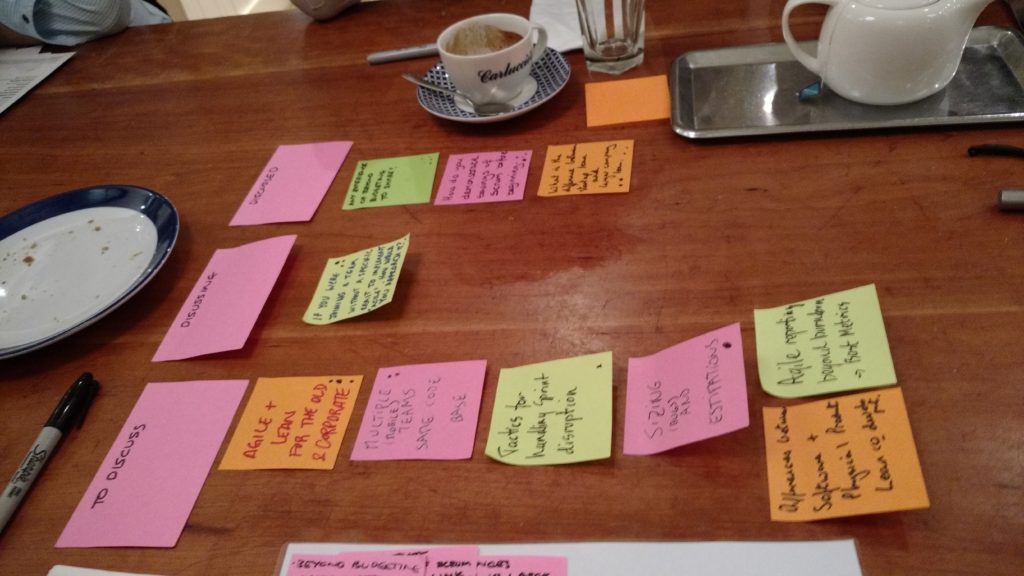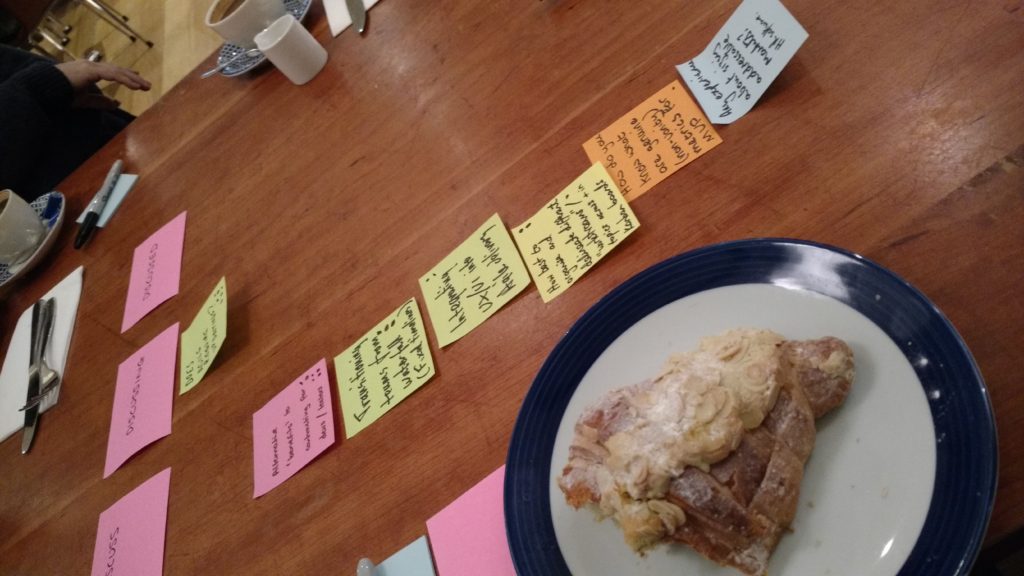I just got sent this great list on how to make a project fail. Hopefully a useful resource of things to watch out for.
All posts by Stephen Janaway
West London Lean Coffee – 2nd March
We had some great discussions at the last West London Lean Coffee session which was held in Carluccio’s in Westfield on 2nd March. Here’s a brief write-up of what we talked about.
What We Discussed
Finding the Right CTO For a Tech Startup
We talked about how to go about finding a CTO. If, as a founder, you have a great idea but no clue about how to get the technology enablers completed in order to get to market then what should you do?
We discussed using specific CTO and founders meetups and websites to help with the search. It’s important to spend a lot of time choosing the right CTO (so many startups fail due to differences of opinion between the founders and early employees). Having a strict spec can be un-helpful and it’s as much about whether one can work with someone, than it is about their pure technical skillset.
There’s also the opportunity to consider part time CTO’s to help guide you. We also talked about whether having one right from the start is even required and that time would be better spent iterating over an idea, testing it through marketing or consumer research, before even thinking about how to partner with someone to built it.
How To Choose The Best MVP
What does a good MVP look like? How do you go about defining it?
We talked about whether it’s actually better to look at Minimum Pitchable Product first, vital for securing funding. We also discussed trialling ideas on customers, segmentation and why it’s important to consider that the customer base is not a base of you.
Revenue can be your best proof of an idea or a minimal pitchable product. You need to prove that you can deliver value.
In that respect I’d certainly recommend reading The 4 Hour Work Week by Tim Ferris which contains a lot of tips.
What Are The Key Behaviours That An Agile Coach Can Demonstrate?
What should you look for when choosing an Agile Coach? What behaviours make great coaches? We came up with this list:
- Calm
- Knowledgable
- Lack of arrogance
- Contextually aware
- They want to make themselves out of a job or contract
- Good agile knowledge but not prescriptive
- Behaviours are the most important thing
Alignment Of Lean/ Agile To Customer Value
How can we ensure we are aligned to the needs and value gained from customers? We talked about gathering value as early as possible. But in order to do that one needs to understand what value means and this has to come from stakeholders. Identification and relationship building with those stakeholders becomes is so important.
How Much Transparency Should a Team Provide During a Sprint?
How much should a team feedback progress during a sprint vs just getting their heads down and getting on with it?
Our discussion started by talking about the pros (stakeholder management primarily) and the cons (perceived lack of trust, reporting overhead) of providing visibility. We agreed that the key point was not to disrupt the team during the sprint and to that end, automated reporting solutions (within popular tools like JIRA, Trello, etc) were key. But on their own reports could be misunderstood and lack context so if teams do want to report during sprint then there is a human overhead to do that, perhaps falling to the Delivery Manager or Scrum Master.
What We Didn’t Get Time To Discuss
- Product Owner role in a larger product company
- How close to an actual customer do you take user stories?
- Sharing failure stories – good or bad
- Process of website up and pitfalls (yep – I don’t understand what this really means either 🙂
- Have you ever worked with someone who stood out in a positive way and why was that?
The next West London Lean Coffee will be on March 30th in Carluccio’s in Westfield at 8:30am. Hope to see you there!
State of Testing Survey 2017
The guys over at QA Intelligence and Tea Time with Testers are running The State of Testing Survey 2017 again this year.
A survey which allows us to get a wider view of our profession and our community can only be a good thing in my book. It can help us understand our joint challenges far better, and to set the future direction. I’ll be a part of the survey and I hope you will be too.
The survey is open. You can find it at the QA Intelligence blog.
Note: I’m not affiliated with the survey or those running it, I think the survey is a good idea so I’m supporting it.
West London Lean Coffee – 15th Dec
We had another great West London Lean Coffee session on 15th December with some excellent discussions.
Here’s what we talked about.
Things We Discussed
Online Boards Vs Physical Boards
We talked about whether it was better for a team to use an online board or a physical one. We felt that for visibility then a physical board could be better, however the use of large touch screen boards means that the line between physical and virtual can now be blurred. The act of physically moving cards on a board has an important effect on people and shouldn’t be discounted. However there is more chance of losing cards from physical boards.
We also talked about how there were various JIRA plugins that could allow you to photograph your physical board and update the JIRA project automatically which are useful. Here’s an example.
Top Three Benefits of Agile For the Customer
We talked about earlier demonstration of value, the adaptive nature of agile to change and how that could help the customer influence a product. There’s also a greater chance of good quality when using agile methodologies
Challenges Implementing OKRs
OKRs are Objectives and Key Results. We talked about how roadmaps could be themed to link results and deliverables to metrics and also the customer impact.
The Best Test For a Service Company
We talked about how validating a service company really shouldn’t be seen as different from a product one, particularly when one looks at how to identify the customer base and test assertions and business strategies on it.
Things We Didn’t Get To
- Top 3 Benefits Of Agile For People In The Business
- Lean Today – Is The Waste Really Eliminated?
- Estimation Costs – Waterfall vs Agile
The next Lean Coffee will be on January 26th. Hope to see you there.
West London Lean Coffee – November
West London Lean Coffee – November. Here’s a write up of the event.
We had a group of 9 people and some great discussions.
Things We Discussed
Experiences of Beyond Budgeting
We talked about experiences of Beyond Budgeting and how working incrementally can help finance teams support agile technology teams. We thought that this would work best in non listed companies, and the key point was enabling buy-in from finance teams to the approach. Wondering what Beyond Budgeting is – look at this post.
How Do You Demonstrate Savings Of Scrum Before You Start?
How can you convince a team to try scrum, or any other agile methodology? How can you demonstrate the savings that could be possible? We discussed how focusing on the outcome was important and how selling a change as a low risk experiment could help you get approval to try something new out. It’s well worth looking at the information that Government Digital Services make available for hints and tips – if it works in government then it must be do-able elsewhere, right? 🙂
The Differences Between Startup Lean and Large Company Lean
Some great discussions about the differences between small and large companies and their cultures. We agreed that behaviour was very important and how the requirement for more structure comes as companies grow. There was a great example of sizes and one scales; making a business unit max 80 people, a squad no more than 12 and teams of 6-8. Once one reaches these limits then it’s most likely time to start thinking about an alternate organisational setup in order to keep a company able to effectively employ agile methodologies
It’s worth checking out Management 3.0 for more details on ways in which you can help build great teams.
If You Were Joining a Team Without a Specific Remit To Implement Agile Then How Would You Approach It?
We talked about how joining a new team is a challenge and how one might initiate change, despite being the new person on the team. The key point were to not focus on agile as such, look at the culture and pain points and lead by example. Use the opportunity of being new to ask simple questions and highlight what might appear obvious. And make sure that the team can see what the improvement could be by using some agile approaches.
It’s also worth establishing if you have a remit to change things and if so, then understand what the change appetite of the company is.
Things We Didn’t Talk About
- Differences between software and physical product lean and development.
- Agile reporting beyond burn down.
- Sizing bugs and estimations. This post from Johanna Rothman could be useful.
- Tactics for handling sprint disruption.
- Multiple mobile teams using the same codebase.
- Agile and lean for the old and corporate.
The next Lean Coffee is on December 15th, 8:30am in Carluccio’s Westfield, Shepherds Bush. Hope to see you there.
West London Lean Coffee – October
Last week saw the latest edition of West London Lean Coffee, slightly delayed from October into early November. We had a group of 8 people and some great discussions.
Things We Discussed
Does Agile Need Updating
A detailed discussion about whether the agile principles are still valid and if they are not then does the manifesto need updating. Is the language right? Is it just a matter of applying general principles to the correct context?
It’s worth reading this article from Ben Linders on the same subject.
Transitioning Teams From Waterfall
How can you transition teams from waterfall methodologies? We talked about the complexities when fixed deadlines are involved and how negotiation with Product Owners is key. We then discussed about the importance of focusing on outcomes and not outputs from a team and avoiding falling into a trap of merely doing mini waterfalls. Identifying where the value is and tying everything to measurable business goals can help. I’ve found a lot of what Johanna Rothman has written to be very useful in the past so it’s worth checking her website out.
Impact mapping is also great at ensuring that the team are focused on outcomes from the start.
Alternate Benefits To Contracting For Developers and Testers
We spoke about the difficulties of retaining employees when the contracting market is so strong and what could be done to help. Focusing on team culture is key and ensuring that there are strong, personal bonds between team members. Treating people like adults and helping them adapt to change, while protecting a team from a lot of outside influence can also help. The focus on autonomy, mastery and purpose in a role can mean that the money aspect becomes far less important.
It’s worth checking out Management 3.0 for more details on ways in which you can help build great teams.
How Best To Organise and Delineate Different Workstreams Across Kanban Boards
We talked about whether it was best to have one large Kanban board that covered a number of different workstreams, or let teams have their own. It was agreed that team ownership of boards was the clear winner and something like a portfolio board could be used to bring the results together if needed. We then talked about how using a tool like JIRA could also help and could be used for reporting as much as tracking.
It’s worth checking out some of the presentations from LeanKit as a starter to learn more and this blog post about Portfolio Kanban.
Integrating UX/UI Into Agile Delivery
What’s the best way to integrate UX and UI design into agile? Do you just have the designers work a sprint ahead? But what happens if there are problems with the designs?
We spoke about how putting regular checkpoints or design reviews into the process can help and getting the ‘QA’ aspects of the design process as early as possible can de-risk having design ahead of development.
Things We Didn’t Talk About
- How do you know what are genuine (non vanity) metrics for MVP? This article could help.
- Any experience about sizing addressable markets?
The next Lean Coffee is on November 24th, 8:30am in Carluccio’s Westfield, Shepherds Bush. Hope to see you there.
My Experiences of WeTest 2016
tl:dr;
I really loved being a part of WeTest 2016. I gave the opening keynote at both conferences, as well as a couple of other talks at sponsor events. If you came to any of them then this post contains some useful links you may want to read. It was great to meet so many engaged and knowledgeable testers in New Zealand.
The Opening
I was thrilled when I was offered the opportunity to travel over to New Zealand and talk at the WeTest 2016 conferences in Auckland and Wellington. I mentioned my conference speaking goal as part of my presentation at both events – this was that one day someone would invite me to speak in New Zealand. And Katrina Clokie, on behalf of WeTest did just that earlier in the year. It didn’t take long for me to agree to be a part of the conference and being offered the opening keynote was a real privilege.
Now there is one thing that’s clear and that is that it is a long way to New Zealand (28 hours to be precise from the UK). So I wanted to ensure that I made the most out of my short time there and to give a presentation that fitted in with the conference theme of “Influence and Inspire”. Given that I have made a move out of a pure test role over the last few years then this seemed like a logical theme for the presentation, and an opportunity for me to give my views, gained from outside of testing, on how testing is perceived. I also wanted to show the audiences that there’s important leadership roles within testing to be taken and made the most of.
Preparation and Arrival For WeTest
I can say without a doubt that WeTest was the best organised conference that I have spoken at and it’s testament to the effort put in by Katrina, Aaron, Shirley and Dan. All too often presenters at conferences aren’t treated brilliantly by organisers – either by having a lack of support leading up to the event, being expected to pay their own way or by needing to foot the bill for travel and accommodation then claim back. WeTest was different – they organised and paid for all travel up front and sent detailed itineraries for each speaker, plans on how the conference rooms were to be setup, as well as ensuring that the simple things like a taxi to pick you up off a long haul flight was pre-arranged. It made the whole experience easy and it made us speakers feel valued. Other conferences should take note.

Up and Away?
My presentation focused on my views of testing from outside of just testing and how I made a move into software management and why. It was part of a clearly well thought out programme and the other presentations, whether focused on more technical aspects such as mobile testing, or other leadership presentation, fitted together really well. You can see the programme here to get a feel.
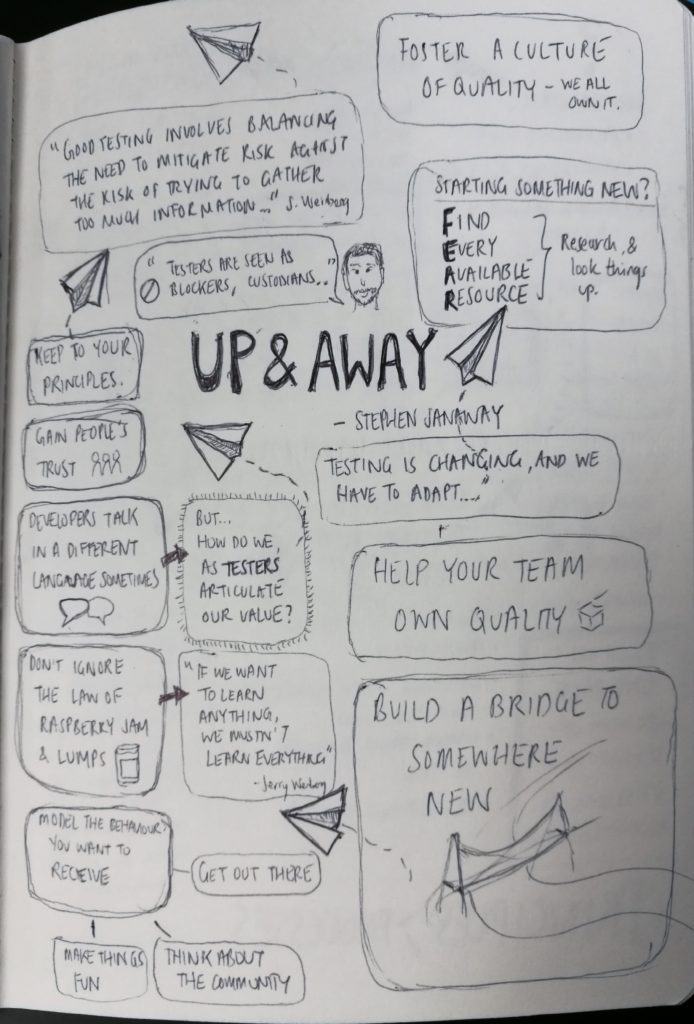
Highlights
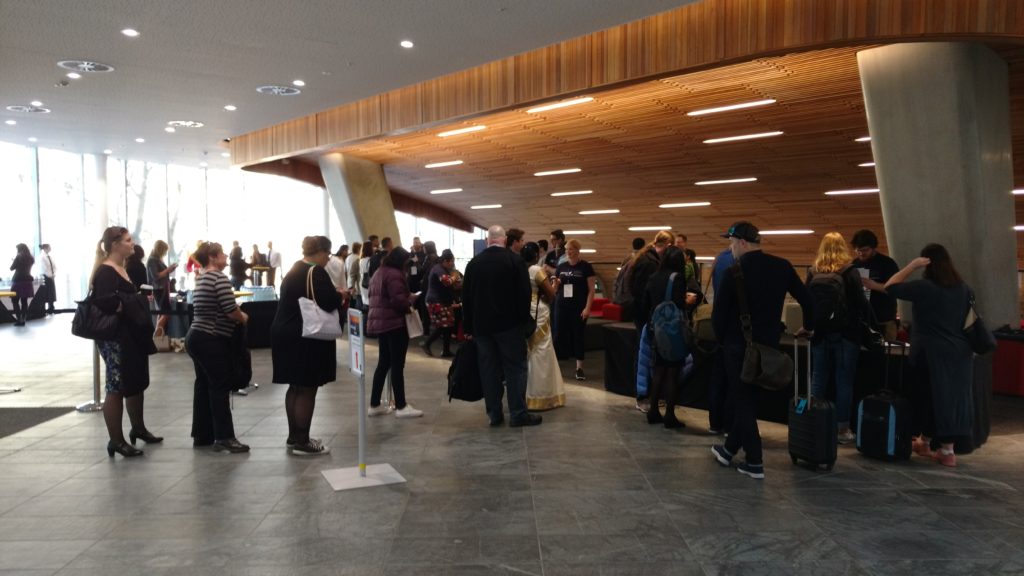
I thought all the presentations were good but a particular highlight for me was Adam Howard’s “Exploratory Testing Live” where Adam took the really brave step of doing live exploratory testing on the Trade Me website in front of a conference audience. Fair to say it went a bit better in Wellington than Auckland, where he found a bug early on that blocked a lot of the rest of the session but he coped really well and there was value in both sessions. We don’t see enough live testing at testing conferences, it’s common to get live coding at development ones but hasn’t seemed to catch on. Based upon Adam’s session then it should.
Also I really enjoyed Joshua Raine’s really personal story about “Conservation of Spoons” which he did as a noslides presentation. Deeply personal at times and spell binding. I won’t give you the details because I’m sure he’ll do this one again and to know the story would spoil it.
A New Approach to Q&A
As part of my presentation I thought I’d try out the new Q&A feature in Google Slides. It turned out that this was a good move because it enabled me to get questions from the audience as I talked and also to keep a record of all of them for later. If you speak at conferences I’d really recommend it.
For those of you who attended then here’s the questions asked, my responses, and a little more information.
What do you most miss about your testing focused roles?
I guess I miss being the expert with the safety of many years of experience of testing. I also make sure I keep connected to the testing community because it’s great and if I didn’t then that would be the biggest thing that I’d miss.
It’s hard to find a balance between adapting and burning out when trying keep up with new trends and technologies. Do you have suggestions on how to manage that balance?
I make sure I do one thing well; that together with Jerry Weinberg’s Lump Law – “If we want to learn anything, we mustn’t try to learn everything” help me to maintain a balance. Trying to find the one thing to focus on is sometimes hard, but by discussing with your stakeholders and your team then you can usually come to find out what is the most important.
Do you have any resources/suggestions for learning to speak ‘Dev’?
There’s not one clear answer to this – it depends on your context, languages and architecture that you are dealing with. When I started then I tended to use google a lot and base my searches on discussions I’d had with the dev’s in my team. I’d also ask them what they thought I should be learning and why. I’ve also found sites like Hacker News and Stack Overflow to be great for keeping up with what’s happening. Talking Code also comes recommended.
Was your career path in the same company or different? Would you suggest to change companies or progress in one?
It was in the same company and I think it’s much easier to make a change from one path to another when you are in the same company. You have that reputation to use and you are a known quantity. It’s also likely that you’d been working towards such a change as part of your personal development anyway so the company will be confident in your plans.
Since we are talking about change, at any given point during those career changes did you resist the change? How did you over come that? Were you specifically looking for change?
I talked about how it can be scary to make changes but trying something new for 6 months is key. You need to understand that you will go through a change curve just like anyone else and things will feel extremely uncertain as a result at the beginning. I knew what to expect since I’ve been through other changes.
In this case I wasn’t specifically looking for change, more for an opportunity.
Thank you for the nice talk If you had to recommend doing ONE PRACTICAL exercise to raise awareness with the team that WE ALL own quality – what would it be?
I like the idea of whole team testing and bug bashes are a great way of starting.
What do you think testing will be like in 10 years time?
I think we’ll see less traditional testing roles and the focus on automated checking will become more of a development activity. This may mean that there are less testing roles in total but good, exploratory, coaching testers will always have a place in teams. I think the biggest change will affect Test Managers, with far less of a need for them and a transition to coaching roles.
How do you avoid being typecast as just being a tester and overlooked for other career opportunities?
Show that you have an interest to others in your company. Work with your manager to map out your path to a new role and start to show that you are learning the skills that will be required in order to be successful at it.
In short – you own the responsibility for your own career.
A lot of people in this company are transitioning from Waterfall to Agile. Some of the people in the room might gain from you talking to how you see that transition working from the experience you bring, especially if they’re concerned about career development and management.
It does depend a lot on how the management structure adapts. In agile transitions that I have been a part of we’ve changed to autonomous, cross-functional teams with single managers, who have been supported by coaches for both agile, testing and development. This support network is key, as is the establishment of discipline based communities. A strong testing community for example, allows testers whose roles are changing to adapt.
I’ve spoken before about the effect of removing Test Managers from an organisation and the biggest takeaway for me was the need for a strong support network for testers afterwards.
Support from coaches allows not only testers to be supported but also means that someone with testing experience becomes responsible for establishing career paths, competency expectations, etc that can then be used by other managers who are not experienced in managing testers. It also helps maintain a ‘voice of testing’ towards senior management and to enable activities that help testers grow within an organisation.
And Repeat…

The first conference was in Auckland and we repeated the experience again in Wellington three days afterwards. This meant that the whole WeTest circus upped sticks and set off for Wellington for a repeat performance. I also did an “Understand Your Mobile Users” presentation at a sponsor the night before, plus the same WeTest presentation at a sponsors internal conference the day afterwards. Four presentations in one week was something new to me and actually pretty interesting to do as I got into the speed of things. It almost felt like being in a band on tour 🙂
Closing Thoughts
WeTest was great. I met some great people and learnt some new things. It was extremely well run by a passionate bunch of volunteers who knew how to treat their speakers well and how to organise a great programme for the conferences. The testing community in New Zealand is really engaged and it’s clear that there’s some really forward looking testers pushing the boundaries here. If you get yourself over to New Zealand then I’d certainly recommend it. It’s not that far. Really 🙂
West London Lean Coffee – 15th September
West London lean coffee runs every month in Carluccios in Westfield Shepherds Bush. Here’s a brief writeup of this morning’s session.
The next session will be on 27th October. Hope to see you there.
Topics We Discussed
‘All Work and No Play’…But How Much Work?’
How much are activities like 10% time and hackathons of benefit to the team and the business? What works for one team may not work for the others. We had some good discussion on context and why giving room for innovation is important.
Agile and Lean For Management Teams
Some great discussion on whether adopting agile and lean works for management teams, a.k.a. the scrum of scrum masters. The idea of quick, focused meetings, transparency and team involvement is important no matter whether it’s a team of developers and testers or a team of managers. Some great tips including ‘make the focus of meetings on how to improve’.
False Agile Promises
What happens when you join a company and you find out that they are not as agile as they implied during the interview? Should you try and change the company from within or cut your losses and move on. The questions that you ask in the interview are important and need to be detailed enough to ensure that you really get a feel for the company culture. We talked about how successful agile transformations are not technology focused and how working with HR and finance first can be the secret to a transformation that works and becomes embedded in company culture.
How Much Are Personas Important When Looking At Market Segments?
We talked about persona’s and how those seeking to validate product ideas can use them. There was some previous experience in the group with the use of persona’s in technology and software development, including testing, in order to understand the customer better. We discussed how segmentation is important but need to be detailed enough to be useful.
Topics We Didn’t Get To
- Working with sales partners and how much to involve them in the design of a product canvas.
- London – high turnover of staff.
- Managing people through change
- Remote teams and tips on how to run them
- Capacity management with stakeholders
- Continuous delivery – how to implement in a new team
- Embracing new tech internally
- Is lean for tech users clients or can we convince business to go with it?
West London Lean Coffee – 28th July
I’m the organiser of the West London Lean Coffee meet-up – here’s a write-up of the July event.
(If you are wondering what a Lean Coffee is then take a look at the Lean Coffee website to find out more).
Topics We Discussed At Lean Coffee
Which Is Better – Move Fast and Break Things Or Test Thoroughly?
A great discussion about whether it’s better to release rapidly and test more in production vs testing and then making a release to production. It’s key in this situation to understand how any changes will be monitored in production, how quickly deployed changes can be rolled back or patched, and how released work is supported. Books like Continuous Delivery and also Lean Startup are good places to start to lean more.
I gave the example of Pokemon Go, where a worldwide phenomenon has occurred and been very successful despite the quality being actually very poor.
Product Manager vs Project Manager
We talked about the differences between product managers and project managers. Is there a difference or is it just semantics? Does the widespread adoption of agile and the product owner role mean that we now see more Product Managers? My take on this is more about permanence – a project is essentially transient in nature and therefore a project manager will manage many different projects over time, whereas a product manager becomes the expert at something more permanent, i.e. a product. But, as was brought up in the discussion, how does one define a product anyway, and since products change so rapidly then is there really a difference between product and project management anyway?
Keeping Teams Engaged
How do you keep a team engaged between projects? Is 20% time, hack days, shipit days and learning enough, when the gap is long and the team’s vision isn’t clear enough? We talked about how you could focus teams, including involving them in project definition decisions as well as the other options mentioned above.
Lean – With a Working Prototype, How Far Back To MVP Should You Go?
We talked about the importance of MVP and how far back towards MVP should you go, particularly when you are a lone inventor of a hardware solution rather than something purely in software. Topics included defining your measurable business goals, how to measure these and how to ensure that you produce a true minimum feature set for validation. And how this is difficult when you have such as emotional attachment to a particular idea.
Topics We Didn’t Get To Talk About
- People management while trying to be agile
- How to work with or manage someone who doesn’t like to document their work in detail
- Experience using lean with physical products (as an aside – if you are reading this and you do have experience then please get in touch)
- Working in an agile manner with consultants
Hope to see everyone next time, which will be in September. If you haven’t been before and fancy coming along then join the meetup group.
Agile In The City 2016
I’ve just got back from Agile In The City, which is a relatively new agile conference held in London. It’s in its second year and this was the first time it had been extended to two days. I had a great time; there was a good mix of talks, tutorials and workshops, a decent venue and even some good food as well.
As usual I did some mind maps of the sessions I attended. My favourite session was Managing For Happiness from Jurgen Appelo, a really inspiring keynote about how to manage better, with some great tips.
My mind maps from all the sessions I attended are below.
Keynotes
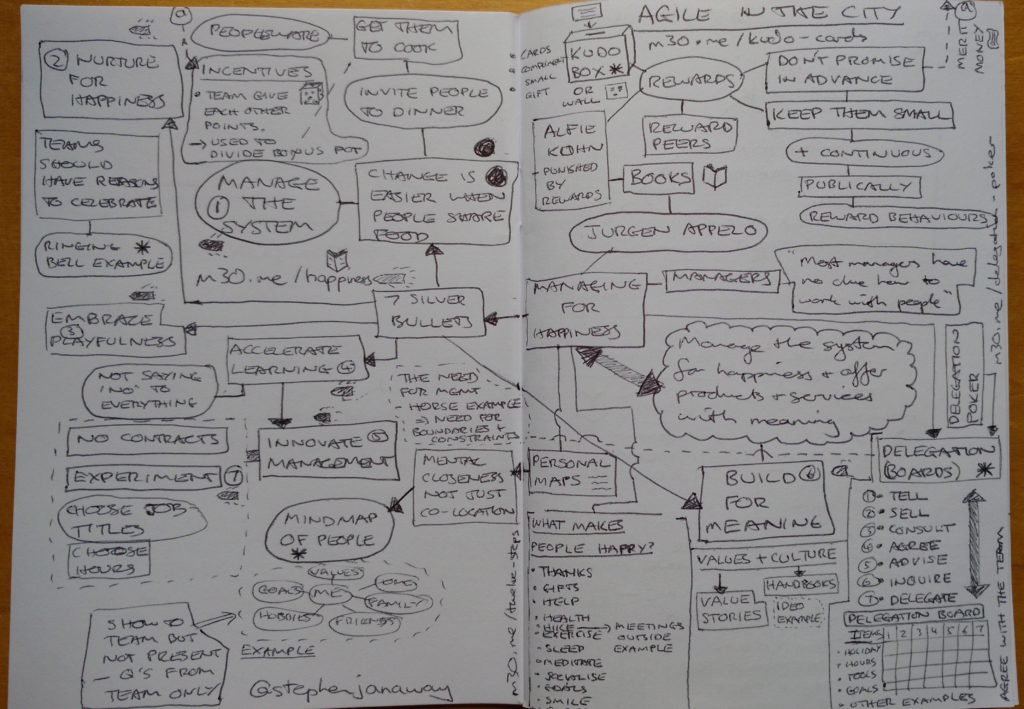

Track Sessions

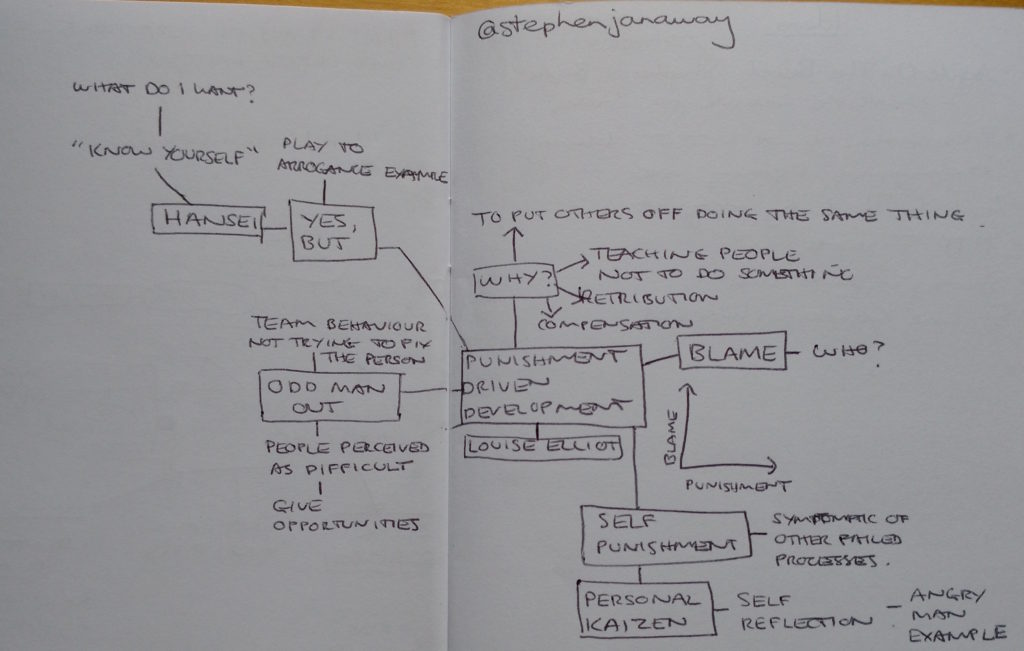
Develop The Product Not The Software – David Leach (with free water pistol 🙂

